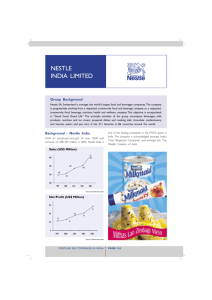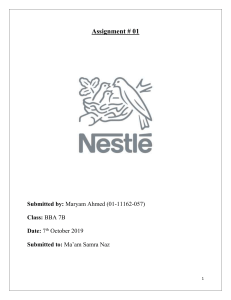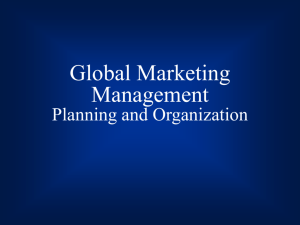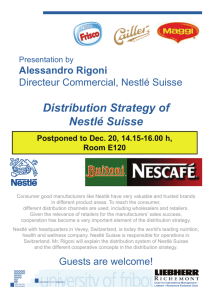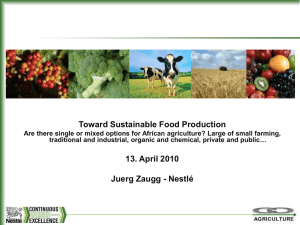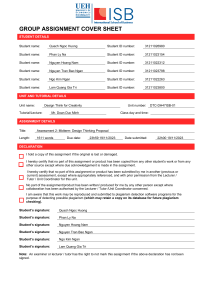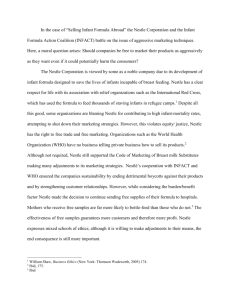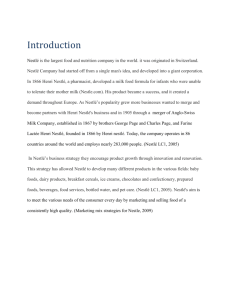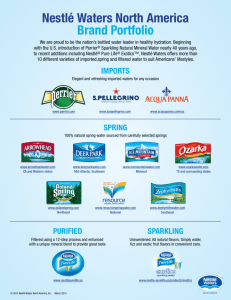Nestle is a global organization The global companies are
advertisement
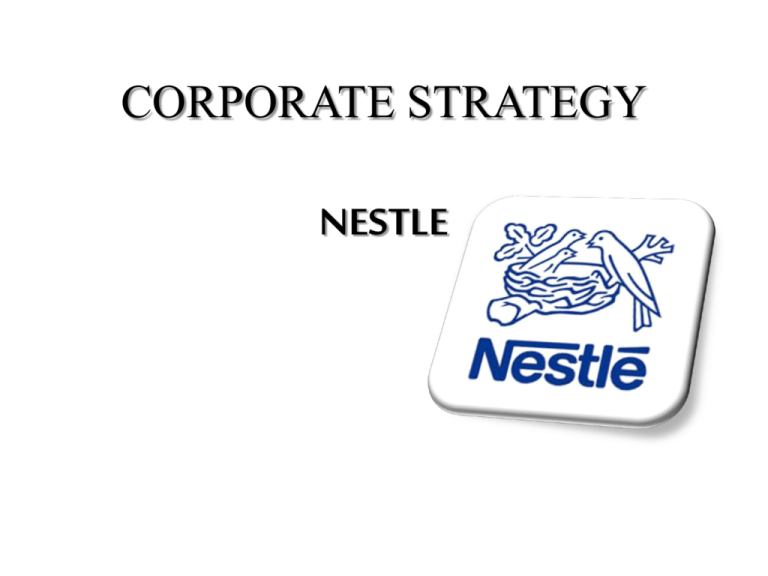
CORPORATE STRATEGY NESTLE INTRODUCTION • It was founded in 1867 by HENRI NESTLE. • Was listed no. 1 in fortune global 500 as the world’s most profitable corporation. • Has 449 factories in 86 countries & employees more than 3,28,000 people. • Mainly deals in chocolates, milk products, maggie ,coffee, mineral water etc. NESTLE The customer groups are divided with respect of their demand of features in the products. Such groups are called Market Segments. The firms divide the market on the base of different factors including region, taste, age group, gender bases, religion beliefs etc. Firms have started targeting the smaller groups in order to satisfy the needs of their customers. o. Region o. Taste o. Age Groups & Genders NESTLE´s CENTRAL GROWTH STRATEGY The nutrition business - Health and Wellness “Our core aim is to enhance the quality of consumers lives every day, everywhere by offering tastier and healthier food and beverage choices and encouraging a healthy lifestyle. We express this via our corporate proposition 'Good Food, Good Life'. Nestle Nutrition program: • • • • Products for infants Young and elderly Health conscious consumers Nestle Home Care (high-nutrition foods and nutrition-related services) DIVERSIFICATION According to the Ansoff Matrix, diversification is the point where the company moves away from existing market and existing products. The strategy of NESTLE when launching the nutrition business is to achieve different markets through different products. It is a competitive advantage that NESTLE has created recently. However this strategy does not drive NESTLE to a Blue Ocean as it does not create an unknown market. The competition still exists in a red ocean, where many companies try to get greater share of existing demand. ACTION FRAMEWORK (Blue Ocean) Drivers of Internationalization Cost Drivers Nestle's market leadership and leading brands provide economy of scale which is important as NESTLÉ has high product development costs. It takes advantages on country specific differences,addapting it´s products to the host country´s. Market Drivers The presence of global customers is a market driver that could be related to NESTLÉ´s need for internationalization. Drivers of Internationalization Competitive drivers Interdependence between countries increases the need of internationalization specially companies like NESTLÉ, which the parent country´s market is too small and the competition is fierce. Globalized competitors would pressure NESTLÉ to adopt an international strategy, as they would be competing with them inside NESTLÉ´s in the domestic market. Drivers of Internationalization Government drivers NESTLÉ´s strategy in foreing markets avoid the disadvantages of policies issues, operationg mainly through joint ventures and partnerships with local companies avoiding this risks. “Part of Nestle's recent success has been down to its ability to weather currency and raw material price Fluctuations. Considering the strategy of acquisition the company will be able In integration of these acquisitions will only improve profits further” THE INTERNATIONAL VALUE FRAMEWORK Unique capabilities: NESTLÉ exploits advantages in technologies and scientific capabilities around the world. It has strong R&D investments in many countries. Product tehcnology centers are present in 34 countries and 4 in-house fundamental research centres counts with partnerships with universsities around the world in order to exchange experiences with their centres and explore overseas knownledge in the filed of new technologies and development. INTERNATIONAL STRATEGIES NESTLÉ international strategy is global. The coordination of the activities is high and Cofiguration of Activities is disperse. Uses international value Networks. ENTRY MODES Joint ventures and alliances NESTLÉ owns some world´s well known brands across diverse products categories. It´s diverse portifolio is it´s global leadership. Enters foreing countries through joint ventures and alliances that avoid the risks of lack of knownlege on target country SWOT ANALYSIS STRENGTHSWell known company and strong brand name. Considered the innovation leader in global food and nutrition sector. Offers thousands of local products, research and development capabilities. Strong workforce. WEAKNESS- • Inability to provide consistent quality in food products • Weak implementation of CSR OPPORTUNITIES • Increasing demand for healthier food products • Establishing new joint ventures THREATSGlobal competitors. Increasing price of raw materials. Highly competitive market, multinational companies are very organized and financially strong.
